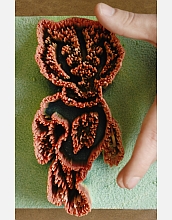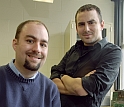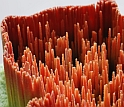|

Press Release 07-034
Getting a Feel for the Nano World

New models help introduce the blind to careers in nanoscale science and engineering
March 27, 2007
When it comes to research at the nanoscale, vision is not necessarily an advantage. The subjects are so small, no one can see them. To encourage people with visual impairments to pursue fields in nanotechnology, educators have developed a way to craft accurate, detailed and touch-friendly models of nanoscale objects like carbon nanofibers, allowing the students to "see" those objects for the first time.
While students have learned from abstract models of chemical structures for decades, the new technique creates 3-D versions of objects as they actually are.
Developed by educators at the University of Wisconsin-Madison (UW-Madison), the models are about the size of a textbook and are formed using rapid prototyping, a process that "prints" 3-D objects. Each model is a scaled-up replica of tweaked data from a scanning electron microscope. The creators hope they will soon be able to apply the same process to data from other instruments, including the patterns of atoms revealed by atomic force microscopes.
The approach was conceived by Andrew Greenberg, education and outreach coordinator for the National Science Foundation (NSF) Nanoscale Science and Engineering Center on Templated Synthesis and Assembly at the Nanoscale at UW-Madison and for the university's Institute for Chemical Education. He thought of the idea during a visit to the Indiana School for the Blind, which uses 3-D models of chemical structures in the classroom.
Greenberg partnered with two collaborators from the university's Center for Biology Education: undergraduate biochemistry student Mohammed Farhoud, who is skilled with the rapid-prototyping equipment, and the center director, David Nelson.
On March 27, 2007, Greenberg and Farhoud presented their novel approach at the 233rd National Meeting of the American Chemical Society.
The effort was supported by NSF award 0425880 and 0411278.
Additional information is available in the University of Wisconsin-Madison press release at: http://www.news.wisc.edu/releases/13601.html
-NSF-

Media Contacts
Joshua A. Chamot, NSF (703) 292-7730 jchamot@nsf.gov
Madeline Fisher, University of Wisconsin-Madison (608) 890-0465 mmfisher@wisc.edu
Program Contacts
Charles D. Pibel, NSF (703) 292-4971 cpibel@nsf.gov
Robert M. Wellek, NSF (703) 292-8370 rwellek@nsf.gov
Thomas P. Rieker, NSF (703) 292-4914 trieker@nsf.gov
Principal Investigators
Andrew Greenberg, University of Wisconsin-Madison (608) 890-1534 greenberg@chem.wisc.edu

The National Science Foundation (NSF) is an independent federal agency that supports fundamental research and education across all fields of science and engineering. In fiscal year (FY) 2009, its budget is $9.5 billion, which includes $3.0 billion provided through the American Recovery and Reinvestment Act. NSF funds reach all 50 states through grants to over 1,900 universities and institutions. Each year, NSF receives about 44,400 competitive requests for funding, and makes over 11,500 new funding awards. NSF also awards over $400 million in professional and service contracts yearly.
 Get News Updates by Email Get News Updates by Email
Useful NSF Web Sites:
NSF Home Page: http://www.nsf.gov
NSF News: http://www.nsf.gov/news/
For the News Media: http://www.nsf.gov/news/newsroom.jsp
Science and Engineering Statistics: http://www.nsf.gov/statistics/
Awards Searches: http://www.nsf.gov/awardsearch/
| 



